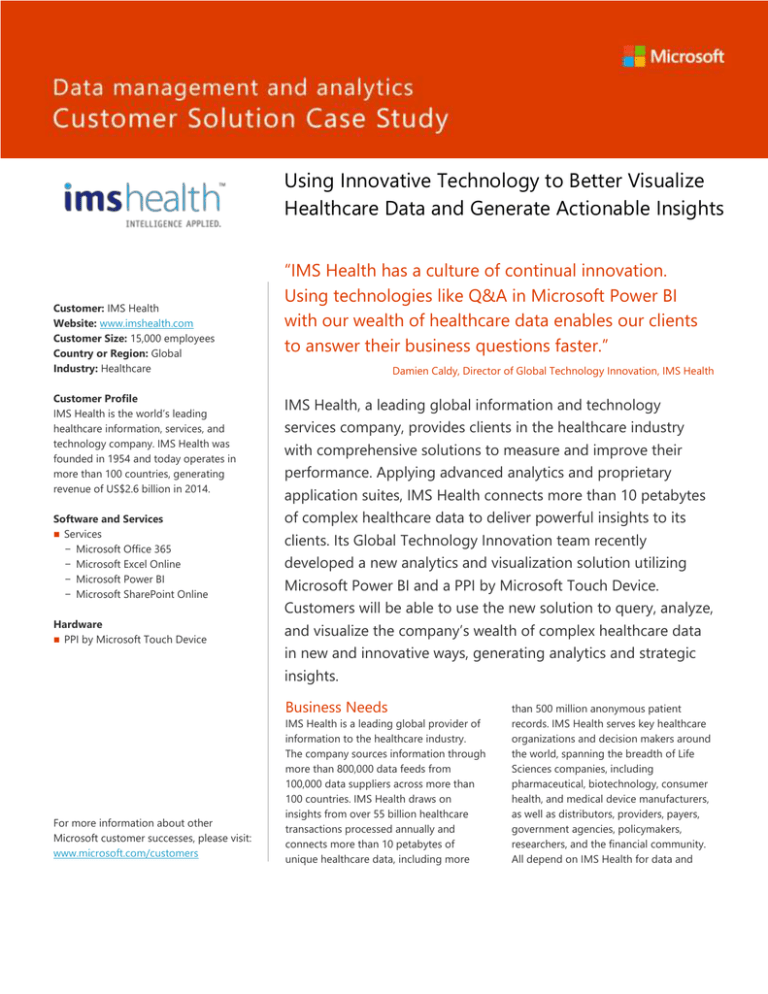IMS Health Case Study
advertisement

Using Innovative Technology to Better Visualize Healthcare Data and Generate Actionable Insights Customer: IMS Health Website: www.imshealth.com Customer Size: 15,000 employees Country or Region: Global Industry: Healthcare Customer Profile IMS Health is the world’s leading healthcare information, services, and technology company. IMS Health was founded in 1954 and today operates in more than 100 countries, generating revenue of US$2.6 billion in 2014. Software and Services Services − Microsoft Office 365 − Microsoft Excel Online − Microsoft Power BI − Microsoft SharePoint Online Hardware PPI by Microsoft Touch Device “IMS Health has a culture of continual innovation. Using technologies like Q&A in Microsoft Power BI with our wealth of healthcare data enables our clients to answer their business questions faster.” Damien Caldy, Director of Global Technology Innovation, IMS Health IMS Health, a leading global information and technology services company, provides clients in the healthcare industry with comprehensive solutions to measure and improve their performance. Applying advanced analytics and proprietary application suites, IMS Health connects more than 10 petabytes of complex healthcare data to deliver powerful insights to its clients. Its Global Technology Innovation team recently developed a new analytics and visualization solution utilizing Microsoft Power BI and a PPI by Microsoft Touch Device. Customers will be able to use the new solution to query, analyze, and visualize the company’s wealth of complex healthcare data in new and innovative ways, generating analytics and strategic insights. Business Needs For more information about other Microsoft customer successes, please visit: www.microsoft.com/customers IMS Health is a leading global provider of information to the healthcare industry. The company sources information through more than 800,000 data feeds from 100,000 data suppliers across more than 100 countries. IMS Health draws on insights from over 55 billion healthcare transactions processed annually and connects more than 10 petabytes of unique healthcare data, including more than 500 million anonymous patient records. IMS Health serves key healthcare organizations and decision makers around the world, spanning the breadth of Life Sciences companies, including pharmaceutical, biotechnology, consumer health, and medical device manufacturers, as well as distributors, providers, payers, government agencies, policymakers, researchers, and the financial community. All depend on IMS Health for data and insights to inform operational and strategic decision making that supports operational efficiency, cost reduction, and reduced risk. The company’s strength is its ability to convert data into intelligence—integrating and analyzing information to generate insights. The volume of healthcare data is growing exponentially, and new structured and unstructured data types—such as social media conversations—are becoming available. The key is being able to use this data to generate valuable insights that support decision making. Often the tools to extract these insights can be difficult to handle, and the volume of disparate and complex data has traditionally limited its use to specialists who have the necessary skills to analyze large volumes of information. The growth and complexity of data increase the need for a self-service business intelligence solution that can turn data into decision-ready insights. Solution IMS Health wanted to determine how new technologies could support the insight needs of nonspecialists. The solution needed to be intuitive and easy to use, and able to analyze large amounts of information in near-real time. Microsoft Power BI was a good fit. Damien Caldy, Director of the Technology Innovation team at IMS Health, explains, “We picked Microsoft BI because the tool proved very strong in analyzing large amounts of complex data and provided innovative features to interact with and visualize data.” Security also factored into the decision. In a proof of concept (POC), the IMS Health team selected complex oncology data from Europe and Asia. Within three months the team created a first-pass product that included natural-language querying capability with Power BI Q&A and sophisticated context-sensitive visualization. The resulting solution enables users to intuitively interact with complex patient data via natural-language queries using either a browser-like search box or voice recognition. For example, a user can ask “What are the top drugs for lung cancer?” The solution translates the question into an analytical query and instantly returns the answer in the form of an interactive chart or graph. The visualization changes as a question is modified. So, for example, if the question is “How many patients have lung cancer by country?” the default visual for the answer is a map. The solution can be accessed using any Internet-connected device via Microsoft Excel Online and the built-in Microsoft Power View for Excel Online. Users can share their analysis with colleagues through a dedicated portal based on Microsoft SharePoint Online. The addition of a Yammer feed enables users to comment on the analysis using a social media–like approach and ensures that comments are retained with a document throughout its life. Taking the POC a step further, an 82” Microsoft PPI touch device—a precursor to Microsoft Surface Hub—was deployed so that users could use touch to interact more directly with the technology. Benefits Using Microsoft Power BI, IMS Health has delivered a new analytics and visualization solution and enabled users to query, analyze, and visualize the company’s wealth of complex healthcare data in new and innovative ways to generate meaningful analytics and strategic insights. This case study is for informational purposes only. MICROSOFT MAKES NO WARRANTIES, EXPRESS OR IMPLIED, IN THIS SUMMARY. Document published April 2015 Access to data for regular users With its intuitive natural-language query functionality, and voice-activated interface, the solution makes it is easy for regular users to interact with large volumes of complex data. Adds Caldy, “What’s great about natural language in Microsoft Power BI is that anyone—a healthcare professional, business executive or sales representative—can immediately get an answer by asking a simple question.” Ability to self-serve Users can access the data and insights they need independently and quickly with minimal instruction. Caldy says, “Instead of asking a data analyst to provide the information, non-power users can get the information they require directly by asking simple questions in plain English.” Answering business questions faster Data is returned quickly and graphically, reducing the need for experts to analyze, format, and chart the information. Notes Caldy, “If a user is in a meeting discussing brand X, he or she can use the solution on their phone and ask, ‘What is the market share of brand X in Germany?’ and instantly get the answer.” Next Steps The Technology Innovation team at IMS Health plans to further develop the solution using other data sources, as well as assess new features such as a built-in virtual assistant with Microsoft Cortana and multilanguage voice controls using Skype Translator.





